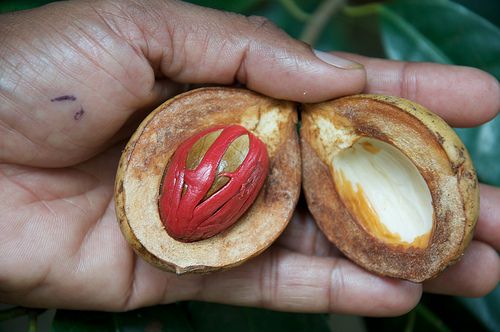Mace, also known as nutmeg mace, which is derived from the nutmeg seed, has a warm, spicy, and slightly sweet flavor. It is often described as having a similar taste to nutmeg, but with a slightly more intense and aromatic quality.
Know More About what does mace taste like
What Does Mace Taste Like: A Sensory Exploration
When it comes to spices, the world is filled with an array of flavors and aromas that entice our senses and elevate our culinary experiences. One such spice that often remains unfamiliar to many is mace. Derived from the same plant as nutmeg, mace possesses a distinct flavor profile that is truly captivating. Today, we delve into the realm of mace, exploring its taste and aroma to unravel its unique characteristics.
Mace, derived from the tropical evergreen tree known as Myristica fragrans, is the delicate, lacy outer covering of the nutmeg seed. Harvested by hand, this ephemeral spice boasts a warm, aromatic scent that entices the senses. As we embark upon a culinary exploration, we discover that mace, although similar to nutmeg in origin, imparts a more refined and complex taste.
Describing the taste of mace can be a challenge, as its flavor is multifaceted, encompassing both sweet and savory notes. At the forefront, mace surprises our tongues with a delectable sweetness reminiscent of cinnamon, with hints of floral undertones. This subtle sweetness gently caresses the palate, leaving a delicate and lingering impression.
As we continue our exploration, we uncover a remarkable depth of flavor that mace conceals within its crimson threads. Beneath the initial sweetness lies a robust, earthy quality, akin to that of cloves and pepper. This warm and slightly pungent component adds a layer of complexity to mace’s overall taste profile. It is this intricate blend of sweet and savory notes that makes mace a versatile spice, suitable for both sweet and savory dishes.
When incorporated into sweet delicacies, mace imparts a gentle warmth that enriches the overall flavor. Imagine a freshly baked apple pie, where the distinctive taste of mace harmonizes with the tartness of the fruit, creating a symphony of flavors that dance across the taste buds. In desserts such as custards, cakes, and pastries, mace adds an exotic touch, elevating the experience with its unique taste and floral hints.
Yet, mace’s versatility doesn’t stop at its suitability for sweet treats. As a spice, it accentuates the savory dimensions of dishes, enhancing their overall complexity. In savory creations, mace works wonders, breathing life into dishes such as stews, curries, and even meats. Its warm and pungent character immerses the taste buds in a tapestry of flavors, offering an intriguing contrast to the other ingredients. Mace’s ability to enhance both sweet and savory dishes makes it an indispensable ingredient in many culinary traditions around the world.
In conclusion, the taste of mace is truly extraordinary, with its multifaceted flavor profile encompassing sweet, warm, and slightly pungent notes. A spice that deserves more recognition, mace serves as an excellent addition to both sweet and savory dishes, offering an exquisite balance of flavors. Its delicate sweetness and alluring warmth make it a crucial ingredient for chefs and home cooks alike. So, whether you are an adventurous food enthusiast seeking new flavors or simply curious about expanding your spice collection, don’t hesitate to introduce mace into your culinary repertoire. Let your taste buds embark on a remarkable journey and discover the diverse wonders that mace has to offer.
FAQs on what does mace taste like
1. What does mace taste like?
Mace has a warm, slightly sweet, and aromatic flavor profile.
2. Is mace similar in taste to nutmeg?
Yes, mace is closely related to nutmeg, so it shares some similarities in taste. However, mace has a slightly more pungent and intense flavor.
3. Can mace be used as a substitute for nutmeg in recipes?
Yes, mace can be used as a substitute for nutmeg in recipes. In fact, many chefs use mace as a substitute when they want a milder and less dominant nutmeg flavor.
4. Does mace have any spicy or peppery undertones?
Yes, mace can have subtle spicy or peppery undertones, adding a unique hint of warmth to dishes.
5. Is mace overpowering in taste?
No, mace is not overpowering in taste. It is fragrant and flavorful, but when used in moderation, it enhances the overall taste of the dish without overwhelming it.
6. Can mace be used in both sweet and savory dishes?
Absolutely! Mace is versatile and can be used in both sweet and savory dishes. It complements a wide range of flavors and adds an interesting twist to various recipes.
7. Are there any specific cuisines that commonly use mace?
Mace is commonly used in Indian, Middle Eastern, and Caribbean cuisines. It adds a distinct flavor to their traditional dishes.
8. How should I store mace to preserve its taste?
To maintain its flavor, it is best to store mace in an airtight container away from direct light and heat. It is recommended to use freshly ground mace for the best aroma and taste.
9. Can I use whole mace instead of ground mace?
Yes, whole mace can be used as an alternative to ground mace. However, it is advised to grind it using a mortar and pestle or a spice grinder for better incorporation into recipes.
10. Are there any health benefits associated with consuming mace?
Yes, mace possesses certain antioxidant properties and may have antibacterial and anti-inflammatory effects. However, it should be consumed in moderation as part of a balanced diet.




Leave a Reply